Last week we had the pleasure of joining James Spencer, the host of Basic Brewing Radio, on his weekly podcast (it’s the October 20, 2011 episode) about brewing. He (and two of his regular guests) interviewed Austin and myself on the ‘spontaneous’ beer I made last October. We had a lot of fun, and enjoyed the beer on the show.
Category: Homebrewing
In case you want make your own beer at home
Building a Keg Totem
After last year’s tailgating season, my friends and I started brainstorming ways to pay tribute to our game-day homebrew. Slowly our ideas grew from a tap attached to a board sunk into the ground, to a way to contain the homebrew and dispense the beer. After the Big Ten college football conference gained a member and divided into two divisions, the Legends (which the Iowa Hawkeyes are in) and the Leaders division, we decided to create a ‘totem’ pole that could hold two homebrew 5 gallon soda kegs, one stacked on top of the other.
Once we decided on our idea, the design was next. What should we make it from? How do we engineer it to dispense the homebrew? After one of our designer friends took the idea and ran with it, we came up with the idea to use 12-inch diameter concrete forms. Two of the tubes are 8 foot tall, and all it took was some engineering to make it all work. The bottom tube is secured with 6-inch L-brackets with removable bolts. The top section has long beams that are secured with bolts, and has a notched hole-less peg board for wings of the top figure. The bottom section contains two gas lines, one for each keg, and the top section has two beer lines, hooking up to tower-style shanks. After several months of planning and design, we unveiled the keg totem at opening day weekend!
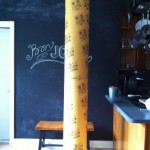

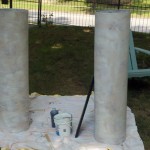




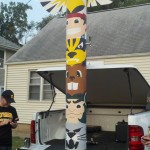
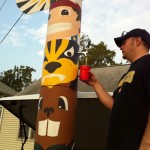
Tailgating With Homebrew – Part 2
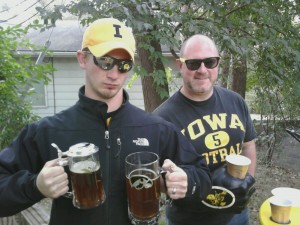
With college football season nearing the end of the season, we take a look back and reflect on how the season went. On the field, things didn’t turn out exactly the way we had hoped, but at least we had a great time tailgating.
This year, we got together every Saturday with our friends, just like last year, and had lots of food with homebrew. Three of us divided up the weeks for home games, and made up a batch for each week to bring to the tailgate.
Some of the different beers we made included a saison, a honey red ale, an Oktoberfest, a trippel, and a Boston lager clone. Each of these beers went very well with the smoked pork shoulders, homemade pretzels, and other food we had.
Here’s the best part: at one point during the season, we started designing a “homebrew keg totem”. Although it never materialized, by next year, we should have it built and ready to go. The design is a twelve-inch diameter PVC pipe, 5 to 6 foot high (which isn’t easy to find). It has two beer taps, and on the back, there’s a post to connect the carbon dioxide tank. It will look like our school mascot, and going to dispense our delicious homebrew.
What’s your favorite tailgating beer? Have you made or had homebrew for tailgating? Let me know!
Beer Brewing for Winter

Over the past three weeks, every Sunday, I’ve been working tirelessly on increasing my winter beer reserves. With family coming to town for Thanksgiving, and an “Ugly Sweater Party” the beginning of December, I had a lot of beer to make.
Starting off, week one, I made a saison, and one of my specialties, caramel apple tart. The previous time I made the caramel apple tart, I used a sour mash, but decided to use a less time consuming method of adding acid malt the last ten minutes of the mash. Here’s the all-grain recipe (let me know if you want more details):
- 6 lbs 2-row malt
- 3 lbs Munich malt
- 0.5 lbs Crystal 40 malt
- 0.5 lbs Special B malt
- 1 lb Acid malt (10 minutes left in the mash)
- 1 oz Willamette hops (60 minutes, 3.5% AAU)
- 1 oz Willamette hops (10 minutes, 3.5% AAU)
- 2 Granny Smith Apples (Julienne’d in the secondary)
- California Ale-type yeast (I used WLP001)
The last time I tried this beer, it was a hit at our engagement party, so much so that everyone kept asking when I would make it again. It’s a nice, slightly tart beer with an aroma of apples and a hint of caramel. It has a very refreshing finish, and leaves a bit of “tart apple” in your mouth.
Week two, I made a nice Belgian Wit and a Samuel Adams Boston Lager (as an ale) clone. These four beers, along with an Oktoberfest done a month ago, give us plenty of beer to have around the holidays.
However, not being satisfied with these for our holiday party, this past Sunday, I made an Oatmeal Cookie Ale (with vanilla and cinnamon), and a Gingerbread Cookie Ale (with ginger, cinnamon, and cloves). I know I’ve said how I dislike spiced winter beers, but I had to make an exception, especially when I keep the spices to a minimum.
Have you made or had any out-of-the-box beers lately? Let me know!
What is Decoction?
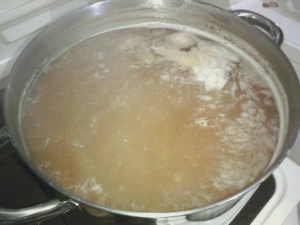
Toward the end of the fall beer season, I like to look back and reflect on how great Oktoberfest beers are. They have a great malty, almost burnt-caramel flavor to them. This is because many of these beers use a process called “decoction”. This is when about 0ne-third of the resting mash is scooped out, boiled, then returned to the original mash. This raises the temperature to a specific level, achieving a higher resting temperature to activate different enzymes.
Decoction mashing was widely used in Europe, specifically Germany, before the use of thermometers because taking out a portion of the mash and boiling it (a constant temperature) successfully allowed the specific temperature values to occur. In addition to this, boiling the grains also made extraction of the starch easier by breaking the cell walls of the grain. Today, this is not as necessary, because most brewing grains are well-modified, so the starches are easily available for starch to sugar conversion.
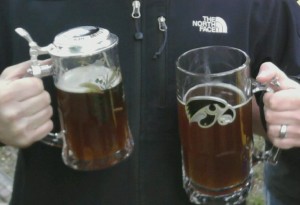
Kind of a “side-effect” of this style of mashing was the introduction of complex, strong caramel flavors from the boiling, called a maillard reaction, producing melanoidins.
These are some of the flavors found in several malt-forward beer styles, such as Oktoberfests, marzens, or bocks. Samuel Adams also uses this type of technique for the Boston Lager.
The decoction process is not used as much today because it is extremely time consuming (up to 3-4 times as long), and is logistically very difficult in large scale breweries. For the homebrewer, however, it may be a process worth exploring.
Have you heard of decoction mashing? What is your take on the process?